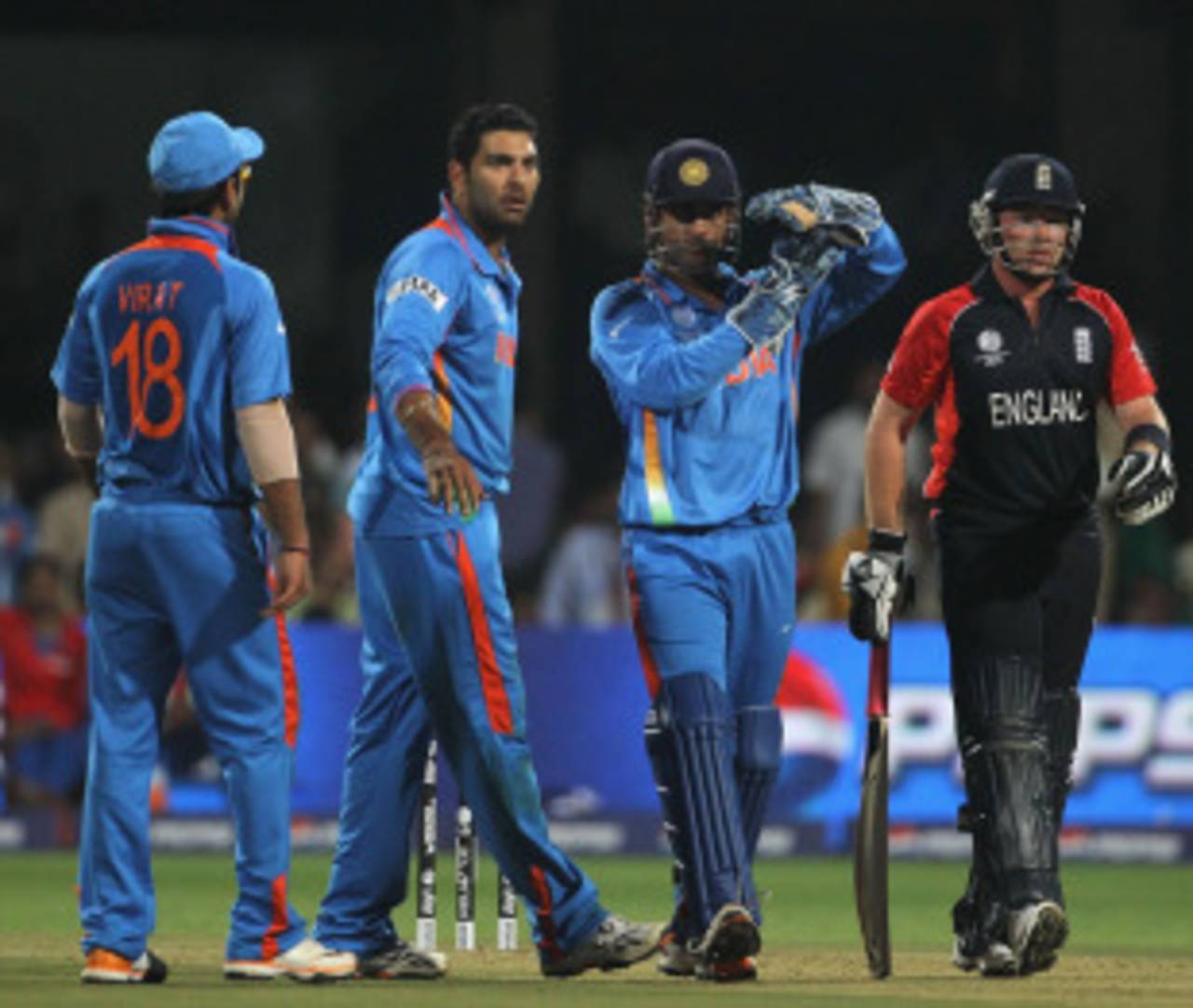Dhoni angered by UDRS ruling
India don't like the UDRS and one moment during the thrilling World Cup group match against England in Bangalore will have given them even more reason to distrust the technology
ESPNcricinfo staff
27-Feb-2011

MS Dhoni called for the review system after Ian Bell was struck in front by Yuvraj Singh • Getty Images
India don't like the UDRS and one moment during the thrilling World Cup group match against England in Bangalore will have given them even more reason to distrust the technology when Ian Bell survived an lbw referral. It left MS Dhoni cursing the system as he called it an adulteration of human decision making and technlogy.
At the start of the 25th over of their gargangtuan run-chase, England were coasting more than 20 ahead of India in comparison. Then Yuvraj Singh struck Bell, who was stretching foward attempting one of those adventurous paddle sweeps, on the pad but umpire Billy Bowden turned down the appeal. The Indians did what they have been avoiding doing for more than two years - turn to the decision review.
The slow motion replay showed up on the giant screen and to the naked eye it met with most criteria: not a no ball, hitting in line of the stumps and striking the wicket. The crowd roared with delight expecting Bell to be on his way and he had already begun his dejected trek back, supposedly out for 17 to complete another unfullfilled one-day innings.
Until, that is, his captain began to holler him to a halt halfway to the dressing room. The last criteria that was showing up on the screen indicated the distance that the ball would have to travel from point of impact to the stumps was more than 2.5 metres, a rule most on the ground did not know about. Not even England.
The 2.5m rule has been put into place because it is from that point onwards that the precision of the ball tracking technology begins to reduce. That last piece of information was conveyed to Bowden by the third umpire and he stuck to his original decision. Not out. Too far down the pitch.
Dhoni was far from amused, finding it difficult to accept that both technology and human intervention played a part in coming to the decision which allowed Bell to survive and make another 52 runs. "Adulteration is quite bad, whether it is natural or technology," he said. "I think the adulteration of technology with human intention was the reason why we didn't get that wicket. Hopefully next time, it will be [either] technology or human intention [in the UDRS]."
The 2.5m ruling surprised most of the players, the England captain Andrew Strauss being informed about it during the review itself. "Apparently if you are that far down the pitch it needs to be hitting middle stump to be given out. I didn't know that was part of the rules," he said. "Obviously Belly was lucky to get away with it."
When he was asked whether he had known about the 2.5m rule Dhoni didn't hide his frustration. "Well, if the Hawkeye says it is going to hit the stump, and it's going to hit the middle stump, then [there is] no reason why the distance really matters," he said.
He went on to recall a dismissal of his own when he had stepped outside his crease and was given lbw after he was hit on the shin. "UDRS was not there...If I can be given out, why not other batsmen? So whether it is 2.5m or 2.4 or 2.6, it is pretty difficult for me. What I saw was the ball hitting the stump. After that, the rest of the rule book is rested with the third and the fourth umpire. Whatever they decided, we said, 'Okay, whatever they decide, we get on with the game'."
The ICC playing conditions relating to this part of the system come under Process of Consultation No. 3.3 (i). It states that if a 'not out' decision is being reviewed and the distance from impact to the stumps is greater than 2.5m then the third umpire passes this information to the on-field official along with: the distance from the wickets of the point of impact with the batsman, the approximate distance from the point of pitching to the point of impact, and whether the ball is predicted to the hit the stumps.
The playing condition goes onto state that: "In such a case the on-field umpire shall have regard to the normal cricketing principles concerning the level of certainty in making his decision as to whether to change his decision."